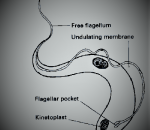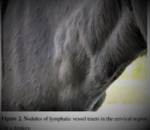Pyometra is the pus formation in the uterus. Pyometra in dogs is an acute or chronic polysystemic, hormonally mediated diestrual (4-8 weeks after estrous) disease. It commonly occurs in older bitches (5 > year old). Pyometra in dogs can occur after
- Secondary systemic bacterial infection
- Postpartum metritis
- Administration of long acting progestational compounds
- Administration of estrogen to mismatched bitches
- Post copulation / Post insemination infection
- Cystic endometrial hyperplasia-pyometra complex (4 gradations)
Progesterone plays major role in developing endometrial hyperplasia, and this condition can be produced most rapidly by the alternate administration of estrogen and progesterone.
Chronic cases of pyometra result in bone marrow depression and anemia due to the toxemic effects. While in acute pyometritis, a high WBC count, and septicemia are common.
Symptoms of pyometra in dogs
- Lethargy
- Anorexia
- Vomiting
- Polydipsia & polyuria
- Purulent Vulvular discharge (in some cases)
- Abdominal distension
- Uterine enlargement
- Dehydration
- Anemia
- Fever (only reported in 20% cases)
- Shock & death
Diagnosis
Pyometra can be of 2 types.
- Open draining pyometra
- Closed pyometra
Open pyometra can be diagnosed with little difficulty, but closed pyometra may be more difficult to diagnose. As we know, both pregnancy and closed pyometra develop following estrus, so one should be very careful to confirm the diagnosis.
Diagnosis will be based on
- History
- Physical Examination
- Radiography
- Ultrasonography
- CBC
- Urinalysis
Differential Diagnosis
- Gastroenteritis
- Renal disease
- Diabetes Mellitus
- Lymphosarcoma
- Diabetes insipidus
- Pregnancy
Treatment of pyometra in Bitch
- Ovariohysterectomy is a choice of treatment (with supportive therapy of systemic antibiotics, fluids and blood if necessary).
- PGF-2 alpha (25-1000 ug/kg of body weight) is used as a medicinal treatment.
- Use of broad spectrum antibiotics along with hormonal treatment is esssential. Parentral antibiotic administration must be continued for at least 10 to 30 days, depending upon severity of the condition. (Chloramphenicol is the drug of choice beacuse of its broad spectrum effect)
- Daily vaginal douches with 200-500 ml of 1% iodine solution are beneficial.
Recovered bitches should be bred on very next estrus. Recurrence of hyperplasia and reinfection are directly related to age and number of non-productive estrous cycles.


